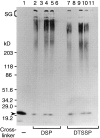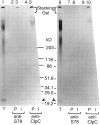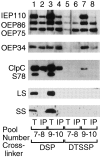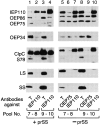Identification of protein transport complexes in the chloroplastic envelope membranes via chemical cross-linking
- PMID: 9060464
- PMCID: PMC2132478
- DOI: 10.1083/jcb.136.5.983
Identification of protein transport complexes in the chloroplastic envelope membranes via chemical cross-linking
Abstract
Transport of cytoplasmically synthesized proteins into chloroplasts uses an import machinery present in the envelope membranes. To identify the components of this machinery and to begin to examine how these components interact during transport, chemical cross-linking was performed on intact chloroplasts containing precursor proteins trapped at a particular stage of transport by ATP limitation. Large cross-linked complexes were observed using three different reversible homobifunctional cross-linkers. Three outer envelope membrane proteins (OEP86, OEP75, and OEP34) and one inner envelope membrane protein (IEP110), previously reported to be involved in protein import, were identified as components of these complexes. In addition to these membrane proteins, a stromal member of the hsp100 family, ClpC, was also present in the complexes. We propose that ClpC functions as a molecular chaperone, cooperating with other components to accomplish the transport of precursor proteins into chloroplasts. We also propose that each envelope membrane contains distinct translocation complexes and that a portion of these interact to form contact sites even in the absence of precursor proteins.
Figures








Similar articles
-
Stable association of chloroplastic precursors with protein translocation complexes that contain proteins from both envelope membranes and a stromal Hsp100 molecular chaperone.EMBO J. 1997 Mar 3;16(5):935-46. doi: 10.1093/emboj/16.5.935. EMBO J. 1997. PMID: 9118955 Free PMC article.
-
Topology of IEP110, a component of the chloroplastic protein import machinery present in the inner envelope membrane.EMBO J. 1996 Aug 15;15(16):4230-8. EMBO J. 1996. PMID: 8861951 Free PMC article.
-
A protein import receptor of chloroplasts is inserted into the outer envelope membrane by a novel pathway.J Biol Chem. 1996 Sep 27;271(39):23846-52. doi: 10.1074/jbc.271.39.23846. J Biol Chem. 1996. PMID: 8798615
-
Molecular chaperones involved in chloroplast protein import.Biochim Biophys Acta. 2001 Dec 12;1541(1-2):102-13. doi: 10.1016/s0167-4889(01)00148-3. Biochim Biophys Acta. 2001. PMID: 11750666 Review.
-
Protein translocation into and across the chloroplastic envelope membranes.Plant Mol Biol. 1998 Sep;38(1-2):191-207. Plant Mol Biol. 1998. PMID: 9738967 Review.
Cited by
-
Precursor binding to an 880-kDa Toc complex as an early step during active import of protein into chloroplasts.Plant J. 2007 Jan;49(1):149-58. doi: 10.1111/j.1365-313X.2006.02944.x. Epub 2006 Nov 28. Plant J. 2007. PMID: 17144891 Free PMC article.
-
In vivo analysis of the role of atTic20 in protein import into chloroplasts.Plant Cell. 2002 Mar;14(3):641-54. doi: 10.1105/tpc.010336. Plant Cell. 2002. PMID: 11910011 Free PMC article.
-
Protein trafficking to the apicoplast: deciphering the apicomplexan solution to secondary endosymbiosis.Eukaryot Cell. 2007 Jul;6(7):1081-8. doi: 10.1128/EC.00102-07. Epub 2007 May 18. Eukaryot Cell. 2007. PMID: 17513565 Free PMC article. Review. No abstract available.
-
Is chloroplast import of photosynthesis proteins facilitated by an actin-TOC-TIC-VIPP1 complex?Plant Signal Behav. 2009 Oct;4(10):986-8. doi: 10.4161/psb.4.10.9665. Epub 2009 Oct 29. Plant Signal Behav. 2009. PMID: 19826218 Free PMC article.
-
Maize non-photosynthetic ferredoxin precursor is mis-sorted to the intermembrane space of chloroplasts in the presence of light.Plant Physiol. 2001 Apr;125(4):2154-63. doi: 10.1104/pp.125.4.2154. Plant Physiol. 2001. PMID: 11299394 Free PMC article.
References
-
- Bruce, B.D., S. Perry, J. Froehlich, and K. Keegstra. 1994. In vitro import of proteins into chloroplasts. In Plant Molecular Biology Manual, J1. S.B. Gelvin and R.A. Schilperoort, editors. Kluwer Academic Publishers, Boston MA. 1–15.
-
- de Boer AD, Weisbeek PJ. Chloroplast protein topogenesis: import, sorting and assembly. Biochim Biophys Acta. 1991;1071:221–253. - PubMed

